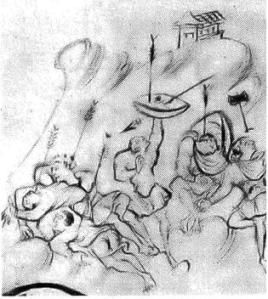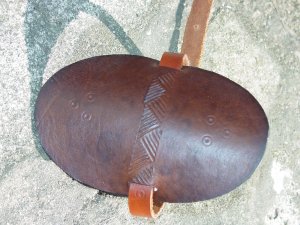This was a commission to make a set of 11th century Saxon arrows and matching archery equipment. The remit was to use original materials, designs and decoration, but otherwise to please myself. The bow had a 45# draw at 28″.
Bracer
Evidence for bracers is missing from this period. The only bracers I’ve seen are 7th – 8th century bone, and 12th century leather. There doesn’t even seem to be any pictorial depictions in between, which is suspicious when details like the knots in the timber and thread binding on the arrows is shown in some of the pictures.
I’ve made a reasonable guess, based on everyone else’s reasonable guesses. It’s a bugger trying to shoot with baggy sleeves without one. The source in this case is Osprey’s Campaign Series 13, Hastings 1066 by Gravett, but I’m not kidding myself that it’s in any way accurate. Made from 6mm veg tanned harness butt and 2.5mm top grain leather. Decoration is dot circle and triangular stamp as on the quiver.
Quiver
We’re on firmer ground here, with quivers mentioned in the seventh century works of Aldhelm; “…just as the warlike bowman… when his bow is tensed by his powerful hands and arms and arrows are drawn from the quiver…” and depictions on the Tapestry. This one is based on the primarily based on the Tapestry, construction methods are inferred from other Saxon leatherwork of the period, such as the shoes from Parliament Street, York. 3mm top grain vegetable tanned leather; buckles are bronze, pine wood disk in the base. Stitching is done with natural undyed hand plied linen thread, beeswax finish over modern dye. Decoration around the top is done using a matched pair of triangular wooden stamps I made to do my saex scabard, and large dot-circle done with a rounded centre punch and a piece of brass tube. Colours are an interpretation of the Tapestry’s colours – I’ve used light brown where the embroidery was light and dark brown where the tapestry uses dark thread. The top roll contains a piece of split willow to retain its shape and protect the arrows when bumbed aginst rocks and the like.

Archers immediately below “Hic Est Williemo Dux” at the end of the Tapestry. Quivers are shown sitting upright on the ground in the next panel, indicating flattish bottoms.
Examples of Saxon Archery

Egil rains feathery death on his house guests. Lid of the Franks Casket, British Museum c.700, British Museum

St Edmund gets nailed to a tree, Life of St Edmund, Bury St Edmunds, c.1120 Pierpont Morgan Library MS M.736, f.14

Rebels cop feathery death Harley Psalter, Canterbury c. 1000. British Library Harley MS 603, Psalm 2, f.2
Sources
Bernstien, D. J., The Mystery of the Bayeux Tapestry, Weidenfield and Nicholson, London, 1986
Gravett, C, Hastings 1066—The Fall of Saxon England, Campaign Series 13, Osprey Publishing, London 1992
Levick, B. http://www.regia.org/warfare/SaxonArchery.htm accessed 25/02/08
Paulsen, Arrows and Bows from Hedeby (Pfeil und Bogen in Haithabu), in Das Archaologische Fundmaterial VI, Von Harm, Schleswig 1999 translated by H. Griffiths.
Strickland, M and Hardy, R, The Great Warbow, Sutton Publishing Limited, Phoenix Mill, UK 2005
Soar, H. D. H., Secrets of the English War Bow, Westholme Publishing, Yardley PA, 2006


I am getting into Renaissnce faires. I need a quiver for my arrows. I have a certain idea about the “character” of what the quiver should look like but find it hard to describe. I do like this one though! Any chance of making another like this one? If so, how much would it cost? I am looking for one that would fit in with belonging to Robin Hood’s Merrry Men.
Barry
I’ve responded to this one privately.
Hello! I stumbled upon this blog and love all the info you’ve provided! Really wonderful work!
I noticed you mentioned above that you have seen evidence of a leather archer’s bracer or bracers from the 12th Century, and I’m curious to know where one might be able to find that. Thanks!
Hi, the bracer in question was found in York in 1999 and was published in AY17-16 Mould, Quinta and Cameron, Leather and Leatherworking in Anglo-Scandinavian and Medieval York. The discussion is on p3404.
The book’s available as a free download from the YAT website.
I imagine the lovely YAT people could point you in the right direction of the original.
Thank you so much! That’s wonderful information!
Awesome presentation, Thank you